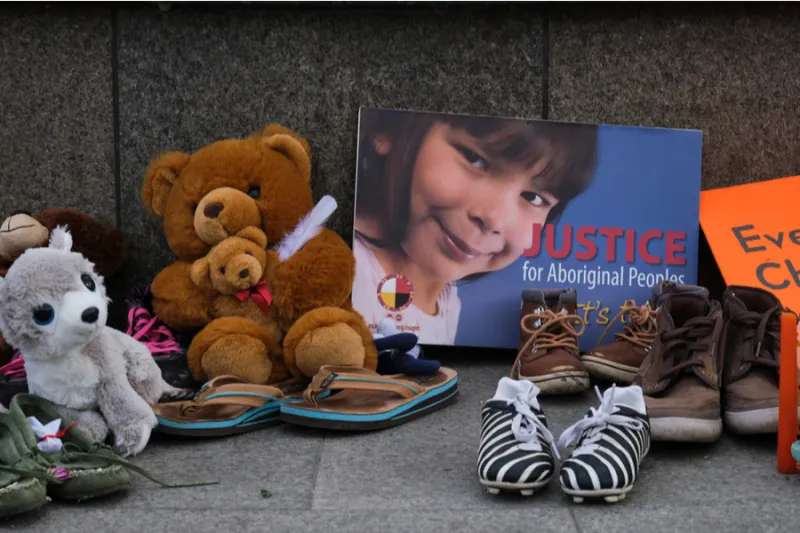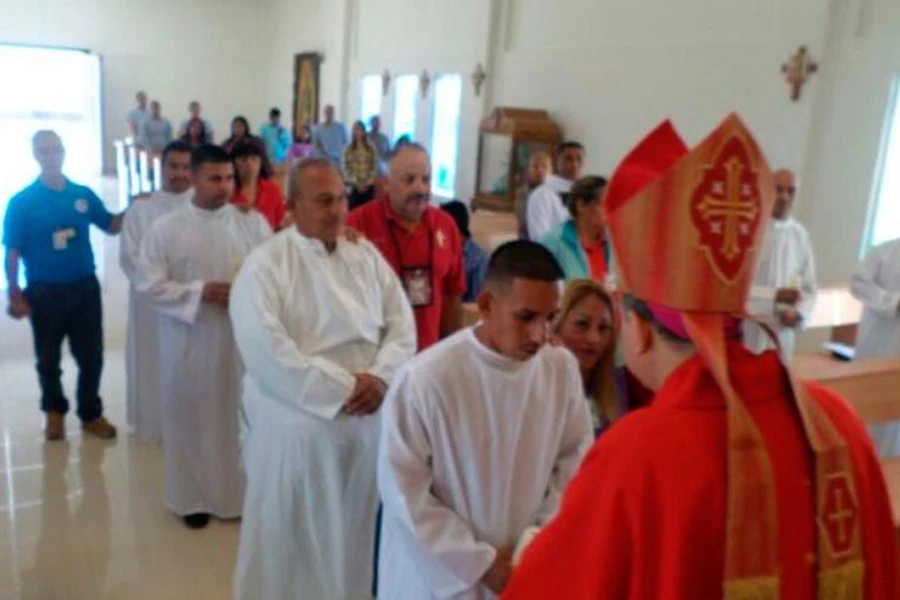
Washington D.C., Jun 25, 2021 / 10:08 am (CNA).
Bishops of the Canadian province of Saskatchewan acknowledged the need for “repentance” and justice, after a new discovery of hundreds of unmarked graves at the site of a former Catholic-run residential school in Marieval.
“We offer our condolences but we know that this is not enough and our words must move to concrete action,” the bishops said in a joint statement on Thursday.
Archbishop Donald Bolen of Regina, Archbishop Murray Chatlain of Keewatin-Le Pas, Bishop Mark Hagemoen of Saskatoon, Bishop Stephen Hero of Prince Albert, and Bishop Bryan Bayda, the Ukrainian Eparchial bishop of Saskatoon, all issued the joint statement.
On Thursday, Cowesses First Nation leaders announced that 751 unmarked graves had been discovered at the site of the former Marieval Indian Residential. First Nation communities are Indigenous peoples in Canada who resided south of the Arctic region, along with Métis communities who share both Indigenous and European heritage. The Cowesses is a First Nations band in southern Saskatchewan.
The Marieval school was run by Catholics from 1899 until 1969. It was constructed in 1899 by Catholic missionaries, and the federal government began funding the school in 1901. The Oblate Fathers of Mary Immaculate, and later the Oblate Indian and Eskimo Commission, ran the school, before the government took control of the school in 1969. The government turned over operation of the school to the Cowessess First Nation in 1987. The school was closed in 1997.
Regarding the discovery of the graves, Cowessess Chief Cadmus Delorme said at a press conference on Thursday, “This is not a mass grave site. These are unmarked graves,” as reported by BBC News.
Chief Delorme stated, “the truth is there,” at the cemetery.
Canadian Prime Minister Justin Trudeau called the discovery “horrific,” and committed “to working together in true partnership to right these historic wrongs and advance reconciliation in concrete, meaningful, and lasting ways.”
The discovery comes after the graves of 215 Indigenous children were found at the site of the former Kamloops Indian Residential School in British Columbia, run by Catholics from 1890 until 1969. The Oblates of Mary Immaculate oversaw the school for nearly all of that time. It is unclear how the children died.
The Truth and Reconciliation Commission – a body called for in a settlement between First Nations leaders and the Canadian government – operated between 2008 and 2015. It reported on the history of the country’s residential school system, including the widespread abuse, neglect, and poor treatment of Indigenous children.
The federal government created the residential school system beginning in the 1870s, and Catholics and members of Protestant denominations oversaw the schools. The system was created as a means of forcibly assimilating Indigenous children, the commission reported, separating them from their parents to strip them of family and cultural ties. The commission found that at least 4,100 children died from “disease or accident” at the schools.
The bishops of Saskatchewan on Thursday expressed support for the “ongoing investigation” of gravesites at former residential schools, while noting that discoveries of unmarked graves “opens deep wounds and brings back terrible memories which re-traumatize.”
“We have heard you telling us that healing and reconciliation can only come after the hard work of listening to the truth, a spirit of repentance, concrete acts of justice, and working with you to bring transformation and healing,” they said to First Nations leaders.
Archbishop Richard Gagnon of Winnipeg, president of the Canadian Conference of Catholic Bishops, called the discovery “very sad and disturbing” in a tweet.
The conference said on June 10 that it has been planning for two years a trip to the Vatican with a delegation of Indigenous leaders, “to meet with the Holy Father to foster meaningful encounters of dialogue and healing.” Indigenous leaders are seeking a formal papal apology for the Church’s role in the residential school system, which was one of the calls of the Truth and Reconciliation Commission. Cardinal Thomas Collins of Toronto has said that a formal papal apology would entail a personal papal visit to Canada, a project which would require significant logistical work.
Other Canadian bishops have recently issued apologies for the Church’s role in the residential school system, including Cardinal Collins, Archbishop Marcel Damphousse of Ottawa, and Archbishop J. Michael Miller of Vancouver. In 2014, bishops of the province of Alberta apologized to Indigenous communities.
Bishop Fred Henry, the retired bishop of Calgary, said in a June 7 letter to Prime Minister Trudeau that while Catholic leaders must “own our sinfulness” in the abuses, the federal government must shoulder its “primary” responsibility for the schools.
He cited findings of the Truth and Reconciliation Commission that the federal government failed to adequately fund and equip the schools, and failed to establish proper health standards and regulations for cemeteries.
“The most basic of questions about missing children—Who died? Why did they die? Where are they buried?—have never been addressed or comprehensively documented by the Canadian government,” Bishop Henry said, quoting the commission’s report.
One of the researchers involved in the commission’s report, Dr. Scott Hamilton, a professor in the Department of Anthropology at Lakehead University in Thunder Bay, said that more work is needed to adequately document the location and scope of cemeteries at residential schools, in an interview with the B.C. Catholic.
The Kamloops discovery “didn’t surprise me, sadly enough,” he said in the interview. “But what surprised me in the years since I was last involved in this file was that there was lots of talk, lots of ‘we shalls’ in 2015. And as an outsider looking in, I don’t detect a lot of substantive action.”
In his 44-page report released after the discovery at Kamloops, Hamilton noted that Indigenous children suffered and died from communicable diseases at much higher rates than the general population in the 19th and early 20th centuries, he wrote, noting the poor conditions at “crowded, often unsanitary, and poorly constructed residential schools.”
At a time when many immigrants and workers were moving into regions with large Indigenous populations, disease spread rapidly and the Indigenous peoples had “limited resistance to infectious disease,” he wrote.
Furthermore, “public health and cemetery regulations were comparatively undeveloped” as provincial and local governments “were either not yet established or were in their infancy,” he noted of that time period. Thus, most residential school graveyards “were established informally, and have left little in the way of formal documentation.” Deaths at schools in the late 19th and early 20th centuries were probably under-reported, especially in “emergency situations during disease outbreaks.”
Even in the cases of documented cemeteries, “some graves may lie unrecognized after the decay and disappearance of wood grave markers and enclosing graveyard fences,” he wrote. The federal government “appears to have been slow to develop a formal policy governing the burial of students who died at the schools,” he wrote.
A government directive from 1958 showed that the Indian Affairs department “was prepared to authorize only minimum funeral expenditures, and would only pay for transporting students to their home reserves if the cost of transportation was less than the cost of burying the student where they died,” he noted.
“This is consistent with practice throughout the system’s history; namely to keep burial costs low and oppose sending the bodies of deceased students back to their home community,” he wrote.
“Consistent with the lack of policy regarding burial of deceased residential school students, no plan appears to have existed regarding maintenance of cemeteries after school closure. Consequently, the current condition of school cemeteries varies widely,” he wrote.
If you value the news and views Catholic World Report provides, please consider donating to support our efforts. Your contribution will help us continue to make CWR available to all readers worldwide for free, without a subscription. Thank you for your generosity!
Click here for more information on donating to CWR. Click here to sign up for our newsletter.





Thanks to Dr. Scott Hamilton for some real information, finally. More, please.